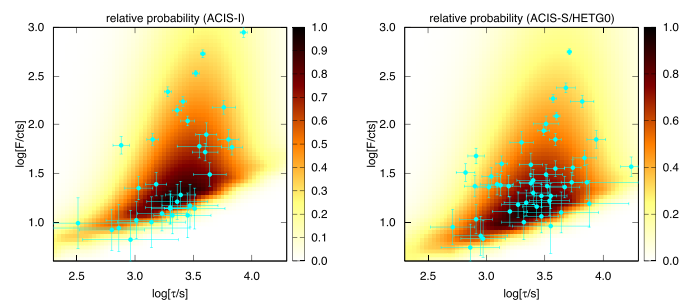The center of the Milky Way hosts a super-massive black hole, which is a unique astrophysical laboratory for studying the accretion physics, interplay between the black hole and the Galaxy, as well as relativistic dynamics in strong gravitational field. Flaring events from the Galactic center, recorded in the X-ray and near infrared bands with a daily rate of several, are believed to be originated from the innermost region of the accretion disk and thus a good probe of such physical problems. In a series of two papers, Dr. Qiang Yuan from Purple Mountain Observatory, together with Prof. Q. Daniel Wang from University of Massachusetts, Prof. Siming Liu from Purple Mountain Observatory, and Prof. Kinwah Wu from University College London, investigated the X-ray flares from the Galactic center in detail with the Chandra observations. They systematically analyzed the Chandra observations on the Galactic center between 1999 and 2012, and detected 82 flares from 84 observations, with nearly 1/3 being newly detected. Then they studied the statistics of these X-ray flares, including their fluence and duration distributions, flare shape asymmetry, and spectral evolution with fluxes, which are potentially useful in revealing the nature of flares. In particular, the detection bias and incompleteness are properly taken into account, which is shown to be very important in correctly obtaining the statistical properties. The results show that the fluence distribution can be characterized by a power-law with a slope of about 1.73, and there is no significant correlation between the fluence and duration. These results indicate that the simple self-organized criticality model has difficulties in explaining the X-ray flares. Furthermore, the light curves of bright flares show typically asymmetric profiles without significant difference between the rising and decaying phases. These effects may reflect the propagation (e.g., gravitational lensing) effect around the super-massive black hole.

Figure. Fluence-duration distributions of the Chandra X-ray flares from the ACIS-I (left) and ACIS-S (right) observations. Shaded regions show the fitted probability distributions of flares convolved with the detection response matrix. The apparent correlation between the fluence and duration is mainly due to the detection effect. These two papers have been published in MNRAS. For more details see links: http://adsabs.harvard.edu/abs/2016MNRAS.456.1438Y http://adsabs.harvard.edu/abs/2018MNRAS.473..306Y |

